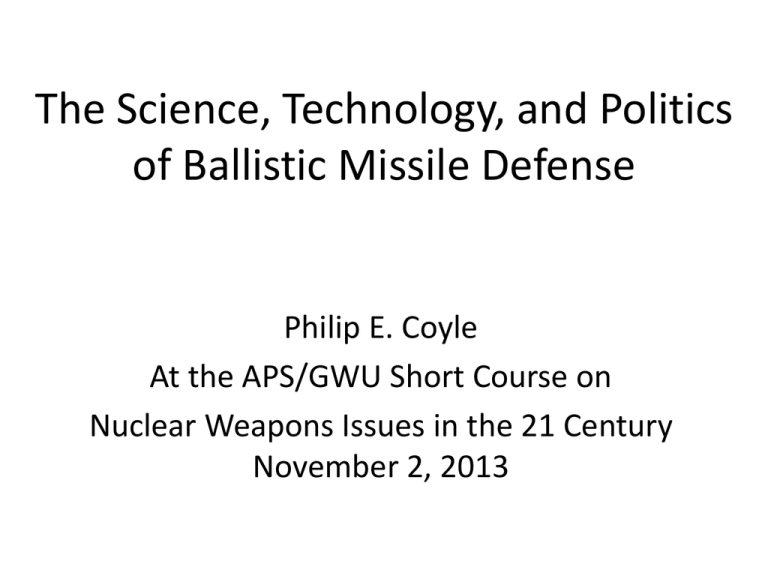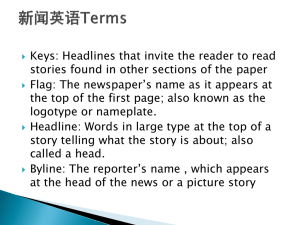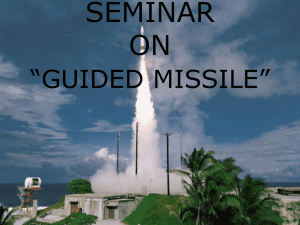Science, Technology and Politics of BMD
advertisement

The Science, Technology, and Politics of Ballistic Missile Defense Philip E. Coyle At the APS/GWU Short Course on Nuclear Weapons Issues in the 21 Century November 2, 2013 Observations • America’s missile defense systems lack a workable architecture and many of the required elements either don’t work or are missing. • Politically the President and both parties in Congress support Missile Defense, and $10 billion plus per year supports a substantial political constituency, largely accepted on both sides of the aisle. • America’s allies expect no less. • The Obama administration is now more involved in missile defense than the Bush administration. • The current articulation of the “threat” does not meet the test of common sense. • Misleading claims of “deterrence” go hand-in-hand with missile defense. • The Administration and DoD are not recognizing the role Missile Defense is playing in justifying more powerful nuclear arsenals for Russia and China. • Russia has more reason to be disturbed by the EPAA than by the Bush approach in Europe. 3 4 “Missile Defense: Toward a New Paradigm” Euro-Atlantic Security Initiative, February 2012 The Ground-Based Midcourse Defense • • • • • • • • No real architecture, e.g. “mothball” Sea-based XBR. Sensors and battle space inadequate to cover U.S. East Coast. 19 flight intercept tests since 1997, (8 hits, 7 kills/19 tries). Since December 2002, 3 hits/9 tries (one no-test). Since December 2008, 1 hit/4 tries. Getting worse with time when it ought to be getting better. Last successful intercept test = 12/5/2008 (FTG-05). FTG-06, January 31, 2010, Missed; FTG-06A, December 15, 2010, Missed; FTG-07, July 5, 2013, Missed. • Next test delayed, now March 2014? • By then will not have had a successful intercept in five-plus years. 7 The Obama European Phased Adaptive Approach • Announced September 17, 2009 • Focused first on near term threats to Europe from the Middle East. • Shorter range threats first. • Longer range threats later. • To hopefully handle larger “raids,” i.e. 20-50. 8 Current and Possible Future Iranian Ballistic Missile Ranges 3,000 km 5,600 km 2,000 km Sejjil 1,300 km Shahab 3 600 km Scud C 9 EPAA architecture is in tatters • • • • • • • • • No viable operational concept. SPY-1 radar = Ineffective per DSB, NAS, and others. AN/TPY-2 Radar = Ineffective; “a waste of diesel fuel”. ABIR = Cancelled by House and Senate Appropriations. PTSS = Not effective; Orbit is too far away; “Cancelled” by NAS Discrimination = Not effective. “Sensory Deprivation” Low Latency Communications = Not developed. Phase I = At best, only a Point Defense. Phase II = No sensors to support the capabilities of the SM-3 Block 1B. No ability to do Kill Assessment so must keep firing until no interceptors remain. • Phase III = No sensors or C2 to support SM-3 Block IIA. • Phase IV and SM-3 Block 2B = “Cancelled” by NAS and DoD. 10 USS Lake Erie Showing SPY-1 radar faces Airborne Infrared Sensor has no viable concept of operations, per GAO. 13 Threat Discrimination (DSB) • “These analyses ….did not account for interceptors launched at non-warhead bodies.” • “If the defense should find itself in a situation where it is shooting at missile junk or decoys, the impact on the regional interceptor inventory would be dramatic and devastating.” DSB Task Force Report, page 27 14 Threat Discrimination (NRC) • “There is no effective ballistic missile area defense that does not require dealing with midcourse discrimination (or shooting at all potential threat objects!).” • “Moreover, “early” intercept, even if achievable from a forward-based interceptor system, cannot obviate the need for midcourse discrimination, because countermeasures and payload deployment can be achieved very rapidly (as historical experience shows) after threat booster burnout.” “Making Sense of Ballistic Missile Defense: An Assessment of Concepts and Systems for U.S. Boost-Phase Missile Defense in Comparison to Other Alternatives”, NRC Letter dated April 30, 2012. 15 Discrimination • “And then I would also agree with Secretary Creedon regarding discrimination. If we can’t discriminate what the real threatening objects are, it doesn’t matter how many ground-based interceptors we have. We won’t be able to hit what needs to be hit.” • J. Michael Gilmore, Director, Operational Test and Evaluation, DoD. Hearing, House Armed Services Subcommittee on Strategic Forces, May 8, 2013. Shoot-Look-Shoot? • Shoot-Look-Shoot (SLS) is still a dream. • The current doctrine is Shoot-Shoot-Shoot. • Meaning five, six, or seven interceptors at each incoming target. • Shoot-Look-Shoot requires “Looking”, i.e. kill assessment, • And kill assessment between each shot, done rapidly. • This would require sensors and discrimination we don’t have, or yet know how to do. Budget Implications? • New Regional Missile defense systems in the Middle East and in Asia? • New, better Aegis SPY-1 Radar (AMDR)? • New Airborne Infrared System? Not ABIR. • 14 more interceptors at Fort Greely and refurbish old Missile Field #1 silos? • 20 new two-stage GMD East Coast interceptors? • More of those to replace existing GMD interceptors? • New bigger better exoatmospheric kill vehicles? • New “East Coast” site, e.g. Fort Drum, NY or Maine? 18 More budget implications • A possible fourth site near Grand Forks, NDak.? • New stacked TPY-2 radars on turntables, and deployed at five new locations around the world as recommended by NAS? • Permanent deployment of the SBX at Adak, AK? • An East Coast SBX? • Development of new space satellite systems to replace aging DSP satellites, and provide midcourse discrimination? • Directed Energy research, a la ABL? • Meanwhile target discrimination is still unsolved! 20 US Missile Defenses in Europe • Bush Plan – Bilateral • US-Poland • US-Czech Republic • Land-based • • • • • • • • • • • • Obama Plan – NATO Poland, Phase III, 2018 Czech Republic Romania, agreed 5/2011, Phase II, 2015 Turkey, “agreed” 9/2011 Bulgaria, cooperation Slovakia, cooperation Georgia, “back up” Baltic Sea, Aegis Black Sea, Aegis White Sea, Aegis Norway, etc. 21 Missile Defense and Deterrence • “By maintaining a credible nuclear deterrent and reinforcing regional security architectures with missile defenses and other conventional military capabilities, we can reassure our non-nuclear allies and partners worldwide of our security commitments to them and confirm that they do not need nuclear weapons of their own.” • Executive Summary, Nuclear Posture Review Report, US Department of Defense, April 2010. 22 Enduring Issues in Missile Defense • U.S. ballistic missile defenses are hobbled by a never-changing set of intractable obstacles that have confounded the DoD for decades: • Terrorism and asymmetric warfare against which missile defenses have little effect. • Cruise missiles, a common missile threat. • The incentive for adversaries to build more offensive missiles and plan raid attacks to overwhelm missile defenses. • Vulnerability to decoys, countermeasures, stealth, and confusion from debris from rocket stage separations. • The slow pace of testing, and excessively scripted tests that avoid the realities of battle and impede effective operational capability. • The worldwide arms race in missile defenses including Russia, China, India, Pakistan, South Korea, Japan, and Israel. • Costs that add to the nation’s fiscal deficit by spending on the deployment of systems that don’t work. • U.S. missile defenses continue to be a major obstacle to improved relations with Russia. Summary • The EPAA and the GMD system both face serious technical obstacles. • The basic architectures of both the EPAA and GMD are in doubt because so many of the parts don’t work, don’t exist, or aren’t achievable. • The bureaucracy is beginning to “accept” large raids, decoys and countermeasures as valid concerns in war. • But we don’t know how to deal with these threats and, without better science foundations, MDA has no viable programs to do so. • Major review and reconsideration is required of all elements of both systems. 26 What can we do? • Keep working with the Russians. • Stop building more of the things that aren’t adequate. • Take seriously the science in the DSB, GAO, IDA, and the National Research Council studies, e.g. HighAltitude Airborne IR Surveillance. • Press for a fresh look at the overall architectures and the lack of effective elements. • Press for the reestablishment of science programs in the MDA budget, e.g. phenomenology. • Take a realistic look at the threat. • Take a hard look at “Missile Defense = Deterrence.” 27 Backups 28 Four Important Assessments • • • • Defense Science Board Task Force Report on “Science and Technology Issues of Early Intercept Ballistic Missile Defense Feasibility,” September 2011. Unclassified. IDA “Independent Review and Assessment of the Ground-Based Midcourse Defense System,” (IDA Paper P4802). Portions unclassified April 11, 2012. GAO-12-486, “Missile Defense, Opportunity Exists to Strengthen acquisitions by Reducing Concurrency,” April 2012. National Research Council, “Making Sense of Ballistic Missile Defense: An Assessment of Concepts and Systems for U.S. Boost-Phase Missile Defense in Comparison to Other Alternatives.” DEPS-NSB-09-04, September, 2012. 29 30 Phenomenology at Launch 31











